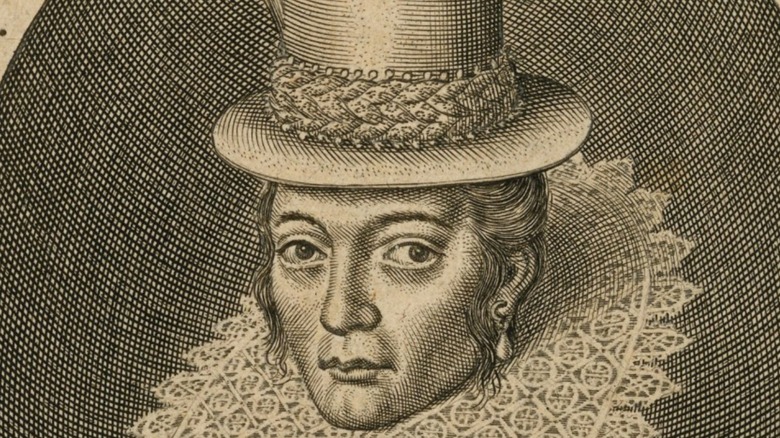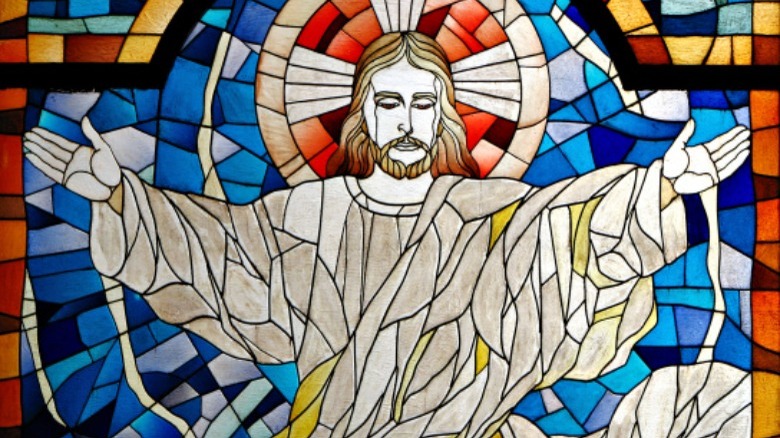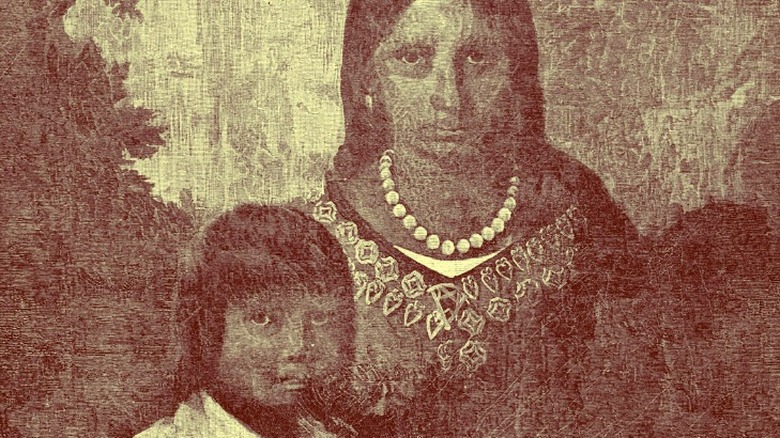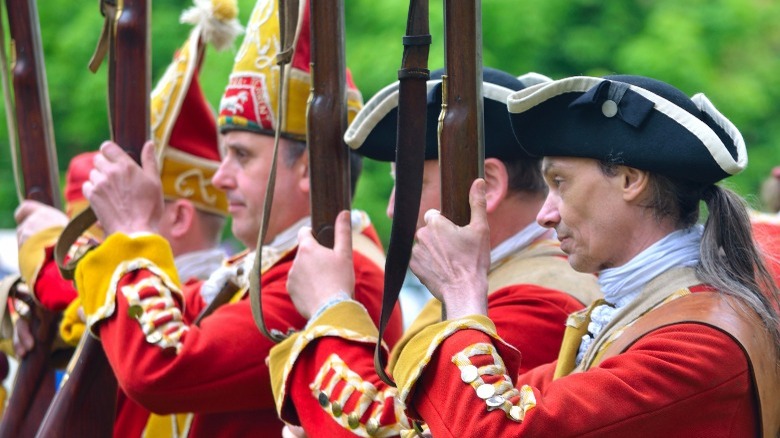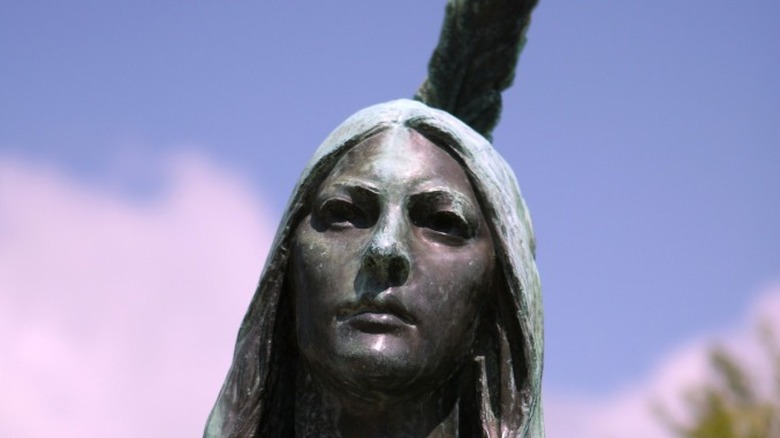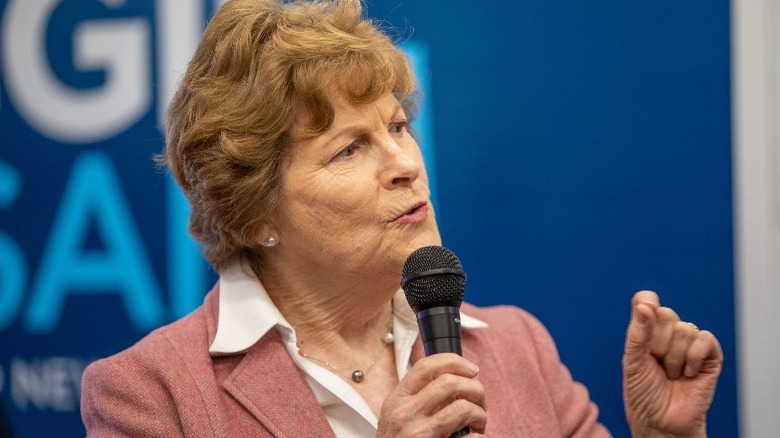Did Pocahontas Have Any Children?
More than 400 years after her death, Pocahontas remains a symbol of peace between English colonists and Native Americans — something that didn't last long. The real-life Pocahontas had a complicated relationship with the English. She did serve as a kind of mediator between the groups, according the National Park Service, often accompanying other members of her tribe to Jamestown when they delivered gifts of food to the colonists. She even played with English children. Years later, however, the English would kidnap her and hold her for ransom. As for saving the life of Captain John Smith? That probably never happened.
After her kidnapping, Pocahontas married an English settler named John Rolfe. She was probably willing to do so to encourage peace between her people and his after years of fighting. It worked; relations between the groups was fairly stable for the next eight years (via History).
Pocahontas had one known child, Thomas Rolfe, whose descendants are still living today. However, the Virginia Patawomeck Tribe's newsletter describes their belief that she may have had a daughter with her first husband, himself one of the Patawomeck. The tribe was part of the vast Powhatan Chiefdom, which Pocahontas' father ruled.
Pocahontas among the English
English records show Pocahontas was living in the Patawomecks' village when she was kidnapped. Though Pocahontas' father was the "paramount chief" of the united Algonquian tribes, each tribe also had their own chief. The English conspired with the Patawomecks' chief to capture Pocahontas. The Mattaponi, another related tribe, now believe the chief went along with the plan to save the rest of his people from danger.
According to the National Park Service, after her kidnapping, Pocahontas was taken to Jamestown, then Henrico, near modern Richmond. Her father immediately began cooperating with the English to pay a ransom, but she wasn't released, and according to Mattaponi oral tradition, the English purposefully sabotaged the negotiations. They also continually told her that her father didn't love her. In the meantime, she learned English and was taught about Christianity. She converted in 1614 and was renamed Rebecca — her third or fourth name, since she was also called Matoaka and was possibly born Amonute. Shortly thereafter, she married Rolfe.
The Mattaponi say Rolfe married her so the Native Americans would help him with his tobacco crops (via National Park Service). Writing to the governor of Virginia, Rolfe himself said he wanted to marry her "for the good of this plantation, for the honour of our countrie, for the glory of God, for my owne salvation, and for the converting to the true knowledge of God and Jesus Christ, an unbeleeving creature" (via Encyclopedia Virginia).
The life of Thomas Rolfe
The Mattaponi allege that prior to her marriage to Rolfe, Pocahontas was raped by an Englishman and became pregnant with her son, Thomas (via National Park Service). Therefore, he may not have been Rolfe's son. However, Rolfe acknowledged him as such, providing for his care after Pocahontas died and leaving him land in his will, per Encyclopedia Virginia.
Thomas Rolfe was born in either 1614 or 1615, depending on the source. In 1616, he went to England with his parents on a sort of propaganda tour to promote The Virginia Company and English settlement there. Just before they were supposed to leave England and return to Virginia, Pocahontas suddenly died. Thomas fell sick at the same time but survived. The above portrait was previously believed to be of the two of them (via Pocahontas Lives).
His father left him with relatives in England, thinking he was too frail to make the journey back to Virginia. They never saw each other again. Thomas didn't return to Virginia until 1635 — 13 years after John Rolfe's death. In Virginia, Thomas had inherited land from both his father and his grandfather, Chief Powhatan. Documents from the period show he was wealthy. Shortly after arriving in Virginia, he married Jane Poythress (via National Park Service).
If you or anyone you know has been a victim of sexual assault, help is available. Visit the Rape, Abuse & Incest National Network website or contact RAINN's National Helpline at 1-800-656-HOPE (4673).
Thomas' later life
The National Park Service says Thomas Rolfe eventually had to choose between the two sides of his heritage: English and Native American. In 1641, he petitioned the governor of Virginia for permission to visit his mother's family. This was granted, and he met with his great-uncle, the new "paramount chief" of the Powhatan tribes. In 1646, however, he joined the English military. The National Park Service says this is the moment he chose sides, because the English military were actively trying to deprive the Powhatan people of their land. His choice also meant his descendants lived in the white world rather than the Native American one.
There are few records about Thomas Rolfe after 1646, but he definitely died before 1698, when his grandson sold land previously belonging to Thomas. Thomas had only one child, Jane. Jane herself had one son and six grandchildren. The Washington Post insists that if you're not descended from one of them, Pocahontas isn't your ancestor. Native Americans aren't so sure.
The mystery of Ka-Okee
Mattaponi oral history says Pocahontas had a son with her first husband, Kocoum, a warrior. The Powhatan tribes had their own form of divorce, so the National Park Service theorizes this is how she was later able to marry Rolfe. However, the Mattaponi say Kocoum was killed when Pocahontas was kidnapped. Their child was safely hidden with someone else.
The Patawomeck tribe think the child was actually a daughter, named Ka-Okee. This is based on extensive research by the tribe's historian Bill Deyo, also called Night Owl. His family had always told him he was descended from Pocahontas, but he couldn't find any link to the Rolfes in his family tree. He did find a Native American ancestor named Ka-Okee who had many descendants through her own daughter, including the Newton family of Virginia.
After Deyo had done his research, Dr. Linwood "Little Bear" Custalow and Angela L. "Silver Star" Daniel published the book "The True Story of Pocahontas: The Other Side of History." It was based on Mattaponis' oral traditions about Pocahontas. Some Mattaponi are descended from Pocahontas' sister Mattachanna. This book said the Newton family were descended from the child of Pocahontas and Kocoum, so Deyo determined the child must have been Ka-Okee. Though it hasn't been definitively proven, Deyo feels certain about his conclusion (via Patawomeck Tides).
Pocahontas' modern descendants
If the Ka-Okee theory is true, Pocahontas has many living descendants through her daughter — Deyo lists 30 different families (via Patawomeck Tides). The Virginia Gazette estimates Thomas Rolfe has around 100,000 descendants. Some of them have been well-known in their own right. These include Thomas Mann Randolph, who married Thomas Jefferson's daughter, and Mary Anne Randolph Custis, who married Robert E. Lee, per The Washington Post. Two of Rolfe's descendants were governors of Virginia: Wyndham Roberson and Harry Flood Byrd (via Patawomeck Tides). Another was a first lady: Edith Bolling Galt Wilson. One of his living descendants is Senator Jeanne Shaheen of New Hampshire (pictured), according to Indian Country Today.
In 2019, an initiative began to identify more of Pocahontas' descendants, including those from the possible second bloodline, her daughter's. It's a joint project of Gloucester County, Virginia; the Rappahannock Tribe; Henricus Historical Park,;and Replenish Richmond (via Virginia Gazette). The project's website explains its goal is to provide "extensive information about Pocahontas and who might be her descendant (through both bloodlines), resources to facilitate an ancestry search, and ways and means to honor Pocahontas by doing good work in her name." There's no telling what the project may uncover.
